Cite this document
(“The Past, Present and Future of RFID Research Paper”, n.d.)
The Past, Present and Future of RFID Research Paper. Retrieved from https://studentshare.org/information-technology/1437115-the-past-present-and-future-of-rfid
The Past, Present and Future of RFID Research Paper. Retrieved from https://studentshare.org/information-technology/1437115-the-past-present-and-future-of-rfid
(The Past, Present and Future of RFID Research Paper)
The Past, Present and Future of RFID Research Paper. https://studentshare.org/information-technology/1437115-the-past-present-and-future-of-rfid.
The Past, Present and Future of RFID Research Paper. https://studentshare.org/information-technology/1437115-the-past-present-and-future-of-rfid.
“The Past, Present and Future of RFID Research Paper”, n.d. https://studentshare.org/information-technology/1437115-the-past-present-and-future-of-rfid.


